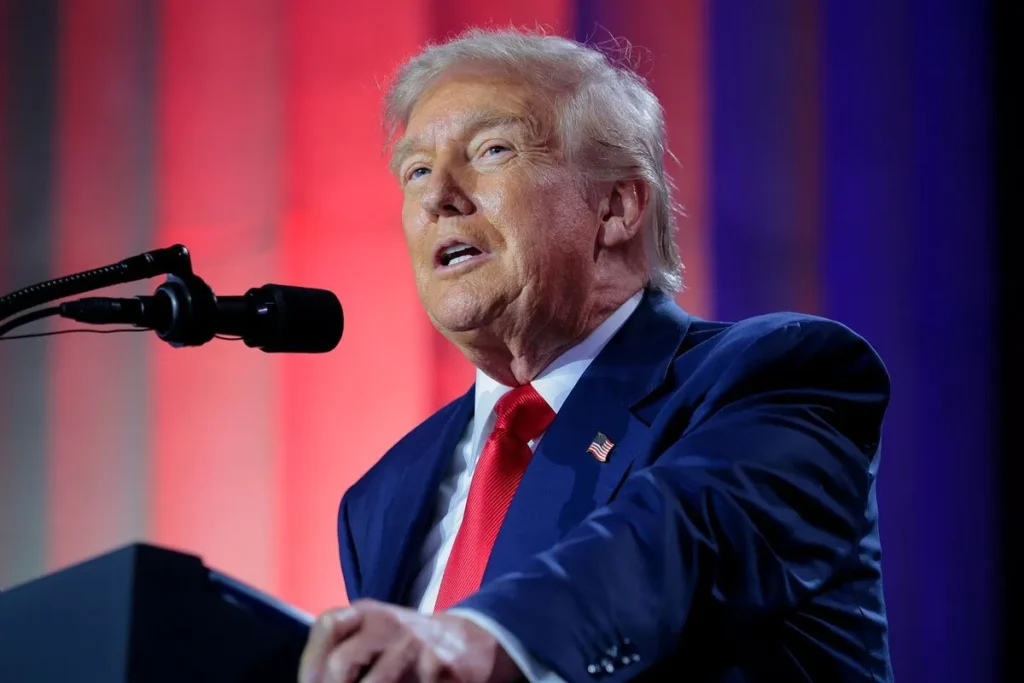In 2025, the intersection of technology and governance has taken center stage in American politics, driven by the return of Donald Trump to the White House. With a sharpened focus on artificial intelligence (AI), digital sovereignty, and ideological control over federal tech infrastructure, the Trump administration is shaping a bold and controversial future for Big Tech in America.
This new chapter blends deregulation with assertive nationalism, emphasizing domestic tech growth, strategic public-private alliances, and strong resistance to what the administration terms “ideological capture” of digital systems. At the heart of Trump’s 2025 vision lies a sweeping AI action plan—designed not only to reassert U.S. dominance in emerging technologies but also to redefine the rules under which Big Tech operates.
AI First: Strategic National Focus
The cornerstone of Trump’s tech policy in 2025 is the formal elevation of AI as a national priority. The administration rolled out a comprehensive plan to remove what it perceives as “bureaucratic red tape” from the AI development pipeline. This includes dismantling prior safety regulations that emphasized ethics, transparency, and human oversight, and replacing them with a pro-growth framework centered around speed, scalability, and innovation.
In practical terms, the government has relaxed constraints on the development and deployment of AI systems across federal agencies, defense, and infrastructure. Agencies are now directed to procure AI tools that are “value-neutral” and “culturally impartial,” which in Trump’s lexicon means stripping federal AI use of diversity training data, progressive language filters, and other content moderation frameworks.
This ideological realignment of technology is a hallmark of Trump’s broader AI vision: a belief that unregulated AI, operating within American values and markets, will naturally outperform state-controlled systems like those seen in China.
Public-Private Partnerships: AI Infrastructure on Steroids
Another central pillar of the 2025 AI action plan is the rapid development of national infrastructure to support large-scale AI computing. To this end, Trump has greenlit vast investment into public-private initiatives designed to build massive data centers and AI processing hubs across the U.S.
This approach, often compared to the space race of the 1960s, aims to leapfrog global competitors in the development of foundational AI models, quantum computing, and high-performance computing. The administration has actively courted private-sector giants to invest in U.S. soil—offering tax incentives, land access, and regulatory relief in return for domestic expansion.
One flagship project involves the creation of a nationwide network of “AI superclusters”—cloud facilities powered by nuclear and renewable energy sources and capable of training next-generation models for defense, healthcare, education, and consumer tech.

Waging War on “Woke” Technology
Perhaps the most controversial aspect of Trump’s tech policy is its aggressive stance on what the administration calls “woke AI.” Government contracts for AI systems now include clauses requiring ideological neutrality, which in practice means excluding datasets or training models that involve race-conscious, gender-inclusive, or socially progressive frameworks.
This has created pressure on tech firms to reexamine the foundational data behind their models—particularly large language models and recommendation algorithms. Companies that wish to work with federal agencies are now auditing their tools to remove perceived “biases,” although critics argue this amounts to censorship, self-policing, and suppression of inclusion-focused design.
This ideological repositioning has sparked intense public debate: Is the government protecting free speech and neutrality, or imposing its own worldview on how machines understand human society?
Antitrust and Market Realignment
In contrast to Trump’s first term, the 2025 administration has taken a more strategic approach to antitrust enforcement. While breaking up tech giants is no longer the focus, the administration is still pursuing selective investigations into digital monopolies, particularly those tied to child privacy, surveillance capitalism, and anti-competitive behavior in app stores and online marketplaces.
Tech firms accused of suppressing conservative voices or refusing to comply with federal AI standards are receiving heightened scrutiny. In the meantime, businesses that are prepared to realign with the administration’s employment and ideological objectives are discovering a more advantageous regulatory landscape.The message is clear: cooperate with the new national vision, and you’re more likely to thrive.
Crypto Renaissance: Deregulation and Strategic Stockpiles
Trump’s second term has also ushered in a dramatic shift in the federal government’s stance toward cryptocurrency. The administration has fully rejected the notion of a central bank digital currency (CBDC), warning that such a system would enable state surveillance and economic manipulation. In its place, the government is pursuing a freer market approach to digital finance.
This includes lifting certain SEC-imposed restrictions on digital asset classification, encouraging banks to adopt blockchain infrastructure, and even creating a federal strategic reserve composed of major cryptocurrencies like Bitcoin, Ethereum, and others.
The aim is not just financial decentralization, but technological independence. Trump’s team believes that a national crypto reserve, supported by infrastructure innovation, could provide a long-term hedge against both inflation and foreign economic threats.
Global Trade & Tech Sovereignty
Trump’s Big Tech agenda extends far beyond domestic policy. On the international stage, the administration has adopted a combative posture toward countries that impose digital taxes or attempt to regulate American tech exports. The administration has threatened retaliatory tariffs on allies that target U.S. firms, further straining relationships with Europe and Canada.
Meanwhile, the government has issued new directives aimed at reshoring American tech manufacturing. Trump has publicly called on companies like Apple, Google, and Microsoft to bring jobs back to the U.S., warning that overseas hiring—especially in China or India—may result in penalties or tariff hikes.
This aggressive nationalism is rooted in the belief that America’s technological destiny must not be beholden to foreign labor, infrastructure, or regulatory frameworks.
AI Ethics, Safety, and Global Isolation
Despite rapid technological gains, Trump’s approach to AI has drawn criticism for abandoning global cooperation on safety and ethics. The administration has refused to participate in international AI treaties and summits, arguing that such agreements limit U.S. sovereignty and give strategic advantages to adversaries.
Without a clear safety framework, the deployment of powerful AI systems in healthcare, law enforcement, and education has raised alarms among civil rights advocates, who worry that unintended harms and algorithmic discrimination could increase.
The administration counters that AI safety concerns are overblown and often used to slow down innovation. In their view, the only true risk is losing the technological edge to China or failing to capitalize on America’s entrepreneurial spirit.
Conclusion: America’s Digital Crossroads
Trump’s 2025 AI and tech agenda marks a seismic shift in how the U.S. approaches innovation, regulation, and ideology. By placing emphasis on deregulation, domestic investment, and political alignment, the administration has turned Big Tech into both a battleground and a proving ground for 21st-century governance.
The policies are ambitious, polarizing, and unapologetically nationalistic. Whether they usher in a new golden age of American innovation—or sow the seeds of global tech fragmentation and domestic inequity—will be one of the defining stories of the decade.
1. What is Trump’s AI Action Plan in 2025?
It’s a national initiative focused on accelerating artificial intelligence development by removing federal restrictions, boosting infrastructure investment, and shifting AI regulation to favor innovation over safety or ethics concerns. The plan positions AI as central to U.S. economic competitiveness and national security.
2. How is the administration changing AI regulations?
Trump’s administration has rolled back previous AI safety rules and introduced policies that emphasize deregulation, faster deployment, and “ideological neutrality.” Government agencies are directed to adopt AI systems that avoid content considered “politically biased,” especially around topics like race, gender, and inclusion.
3. What is being done to support U.S.-based AI infrastructure?
Large-scale public-private partnerships have been formed to build AI data centers and high-performance computing hubs across the country. These projects aim to create “AI superclusters” that will host training infrastructure for defense, education, healthcare, and more.
4. What does “anti-woke AI” mean in this context?
The administration is targeting AI tools that incorporate diversity, equity, and inclusion (DEI) principles—calling them “woke” or politically biased. Contractors must now ensure their AI systems are free from such ideological inputs to be eligible for federal contracts.
5. How are Big Tech companies being treated under this administration?
Trump’s administration is taking a selective approach to Big Tech. While easing restrictions on mergers and innovation, it is also investigating companies accused of censorship or perceived ideological bias. Those aligned with the administration’s goals are more likely to receive favorable treatment.






